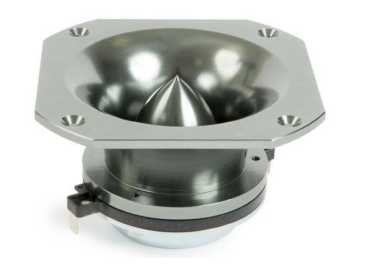In this blog post I test the Ciare CT440 Horn tweeter.
The manufacturer's specification sheet can be found here.
The product page can be found here.

The tweeter retails for €131.22 ($171 CAD) each.
My customer sent me the driver to evaluate. I have no commercial interest or conflicts in this review.
Physical Features
The bullet and horn are made from nickel plate aluminum which is quite attractive. The square flange allows close placement to other drivers, although it makes flush mounting difficult.
The tweeter is actually quite large. My hand is shown for scale and I have big hands.

I custom machined a baffle to test the tweeter. I used an old piece of circular wood and machined the edges smooth to reduce diffraction.

The driver has to go in at an angle to clear the terminals through the driver mounting hole.

Measurements
I started with an impedance sweep. The driver represents and easy load of 8.5ohms. Based on these results I would not cross the tweeter any lower than 2kHz. The cleanest part of the spectrum is in the region from 6kHz to15kHz.


Below is the standard set of test data on the tweeter. The tweeter measures quite flat from 5kHz to 20kHz.

This matches closely with the published data. My results don't show such as severe shelf starting at 9kHz. It's not common that my measurements show better results than published.

I then measured the off-axis response in the form of a coloured polar map.
I was not able to normalize the response on-axis due to a limitation within ARTA when measuring tweeters. But you can get an idea that the driver is very directional especially above 10kHz. The listening window in the region is only 40 degrees total. Normally we would like to see something twice as wide. Another feature worth noting however is that the off-axis is very well behaved, having a consistent character with the on-axis response. This indicates that the horn is not going to colour the sound with acoustical resonances, diffraction, or resonances.

To highlight this further I've displayed the 0,15,&30 degrees overlay in the graph below. You can see that 30 degrees off-axis the response just drops like a rock. 30 degrees would represent a 60 degree listening window which this driver clearly does not achieve.

Time Domain Performance
Below is the burst decay result. It shows a very clean decay even with the vertical scale set to 35dB. I did not use any gating on this result. The mic was placed about 7cm from the horn mouth.

Below is the CSD plot. It again, shows a very clean nature with just a small resonances in the 5kHz region which also shows up as a dip in the on-axis frequency response. But if we use the tweeter above 5kHz then this will be avoided anyways.

The step response is shown below. The step response is shockingly fast and extremely well behaved. It's not often I see a step response with such a fast rise and decay, along with very little overhang after the initial impulse.

Distortion
Below is the distortion results starting with 80dB and incrementing up 5dB in each graph until we reach 100dB SPL at 1m. The results are shown with a 3kHz LR2 high pass to protect the tweeter.
Generally distortion is very low on this tweeter. The driver can easily maintain a -65dB noise floor even at 90dB SPL. Even at 100dB SPL distortion is low at -55dB (6kHz region).





Subjective Listening
I briefly evaluated the tweeter with a variety of music. The tweeter sounds excellent with great overall clarity and smoothness. From my short listening session I would put this tweeter on par with the Fostex T96A or other small format compression drivers when listening on-axis. The narrow coverage off-axis means limited overall soundstage width. This tweeter would require a dedicated listening position so as to not move out of the sweet spot. If you just want the great clarity and don't care about soundstage width, then this may be the a good solution. Also, if you have terrible room acoustics and want to limit room reflections, then this could also work. The reality is that this tweeter has about the same directionality characteristics as a 6" or 8" fullrange driver. So if you are used to that, then maybe it's a workable driver for you.
